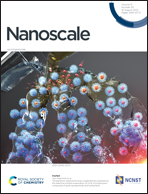Spectrotemporal characterization of photoluminescent silicon nanocrystals and their energy transfer to dyes†
Abstract
Silicon nanocrystals (SiNCs) are a promising material for applications in bioanalysis and imaging. Compared to other types of semiconductor nanocrystals, the development and characterization of energy transfer (ET) configurations with SiNCs has been far more limited, resulting in an equally limited understanding of this process and its SiNC-specific nuances. Here, we present a systematic and detailed study of ET between SiNCs and dyes. A combination of spectroelectrophoresis and time-gated and time-resolved photoluminescence measurements were used to characterize the photophysical properties of ensembles of SiNCs and gain insight into how these properties varied as a function of nanocrystal size. ET between SiNC donors and a series of non-fluorescent Black Hole Quencher (BHQ) dyes and fluorescent sulfo-Cyanine 5.5 dye acceptors was evaluated in terms of spectral properties, wavelength-resolved efficiencies, trends with spectral overlap integral, and differences between two methods of BHQ association with the SiNCs. The overall results were consistent with a Förster resonance energy transfer (FRET) mechanism where the polydispersity of the SiNCs had a significant impact on the observed ET: the choice of wavelength and timing parameters were important, and ensemble measurements represented an average of heterogeneous ET behaviors. Prospective advantages and disadvantages of SiNCs as ET donors are discussed. This study serves as a foundation for the continued and optimized development of ET configurations with SiNCs.



 Please wait while we load your content...
Please wait while we load your content...